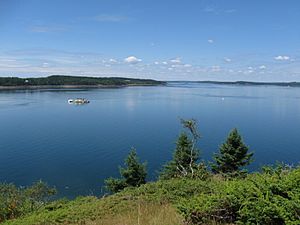Cobscook Bay facts for kids

Cobscook Bay is a large bay in Maine, a state in the United States. It's found in Washington County and connects to Passamaquoddy Bay, which is part of the huge Bay of Fundy. The city of Eastport is right next to Cobscook Bay.
Back in the 1930s, people had a big idea for Cobscook Bay. They wanted to build a "Quoddy Dam" to make electricity from the bay's powerful tides. This project was never finished, but it shows how special the tides are here!
Contents
Exploring Cobscook Bay's Geography
Cobscook Bay is a big body of water in Maine. It connects to Passamaquoddy Bay through a narrow opening. The bay is about 10 miles (16 km) long and 10 miles (16 km) wide. It has a very twisty coastline with many islands.
The city of Eastport and the town of Lubec are at the bay's entrance. Other towns around the bay include Perry, Pembroke, Dennysville, and Edmunds. About 7,000 people live in this area. Many work in fishing, fish farming, shipping, or tourism. There's even a special fishery for scallops here.
Tides and Water Life
Cobscook Bay is unique because of its tides. The water level can change by about 18.4 feet (5.6 meters) on average. Sometimes, it can change by more than 26 feet (7.9 meters)! This creates very strong currents as huge amounts of water flow in and out twice a day.
The bay is quite shallow, with an average depth of about 10 meters (33 feet). About one-third of the bay's area is exposed when the tide is low. Not much fresh water flows into the bay from streams. However, the ocean water is full of nutrients. These nutrients help many tiny plants (called phytoplankton) and algae grow.
These tiny plants and algae are food for many different sea creatures. You can find lots of fish, shellfish, marine worms, and other small animals without backbones (called invertebrates). Many birds come to feed on these creatures. The bay is a very important stop for migrating birds and waterfowl.
Land Around the Bay
The land around Cobscook Bay is mostly covered in forests. But you can also find streams, lakes, wet areas called bogs, and muddy flats. There are also many trails for exploring the area.
Cobscook Bay's History
For a long time, the communities around Cobscook Bay were busy with different jobs. People built ships, cut down trees for wood, farmed, fished, and traded goods.
The Quoddy Dam Project
In 1935, a big project was started to use the bay's powerful tides. FDR, who was the US President, supported the idea. The plan was to build a dam to trap the water from Cobscook Bay and Passamaquoddy Bay. This would create electricity.
Some parts of the dam were built, but after about a year, the United States Congress stopped giving money for the project. So, the plan was abandoned. Today, you can see a large model of this project at the Quoddy Dam Model Museum in Eastport.
Modern Tidal Power
Making electricity from the bay's tides finally happened in 2012. A company called Ocean Renewable Power Company installed a special turbine in Cobscook Bay. This turbine could make 180 kilowatts of electricity. It was the first time in North America that a tidal energy project sent power to the electrical grid.
These new turbines don't need dams. They sit on the seabed, and their blades spin slowly with the current. Tests show that they are safe for marine life. More turbines were planned to be installed in the bay later.
Wildlife and Ecology of Cobscook Bay
This coastal area is home to many birds that live here all year. One special bird is the bald eagle. Cobscook Bay has more pairs of these amazing birds per square mile than anywhere else in Maine. It also has 25% of the state's black duck population.
In the fall, many birds stop at the bay as they fly south for the winter. You might even see rare birds like the harlequin duck. There's also a unique tiny land snail called the mystery snail (Vertigo paradoxa).
In the summer, several types of whales visit the bay. These include the minke whale, fin whale, and the very rare right whale.
Protecting Cobscook Bay
People are working hard to protect the many different kinds of plants and animals in the bay. A special "buffer zone" has been created. This is a 250-foot (76-meter) area next to the shore where no new buildings or development are allowed.
Another important effort is helping the alewife fish (Alosa pseudoharengus). These fish swim upstream from the ocean to lay their eggs. People are trying to help them reach their old spawning grounds in rivers like the Pennamaquan River. These fish are very important because they provide food for the eagles and other animals in the bay's ecosystem.
Other Uses of the Name
"Cobscook Bay" is also the name of a song by the band The Mountain Goats. It's on their music album called Isopanisad Radio Hour.
Images for kids


